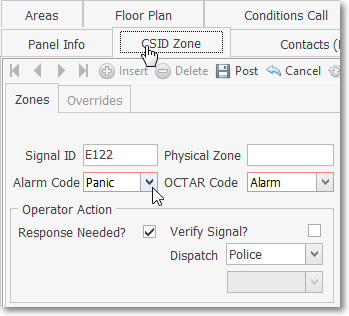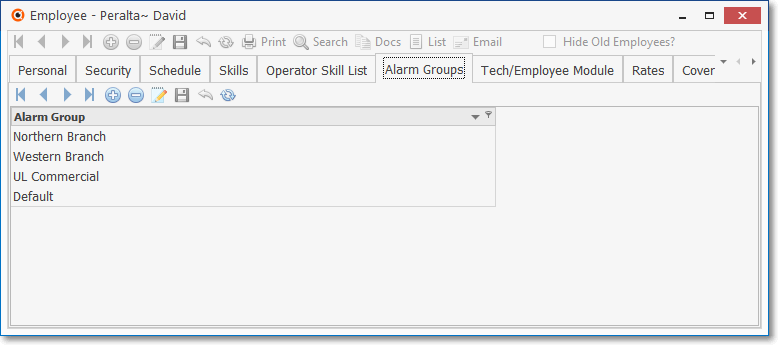❑The MKMSCS Central Station Monitoring Module provides automated Alarm Signal Processing and many other monitoring related features and functions.
•All Monitoring Data, including Subscriber Entries, Monitoring Information, and Start-Up Maintenance Entries for this Central Station Monitoring Module, is entered using the MKMS module.
•Before you attempt to use the MKMSCS Central Station Monitoring Module, ensure that you have completed the following:
1.Central Station User Options for setting the general rules; and Company Setting options for how your Company wants the Monitoring Module to operate.
2.Central Station Maintenance Entries which define all the codes, the Communicator Formats, and other basic monitoring related information.
3.Operator Skills and Security Settings relating to the Monitoring Module.
4.Subscriber Entries for monitored Accounts.
5.MKMS General Menu Entries relating to the Monitoring Module.
6.Installed the SPA - Signal Processing Application and have identified and connected your Company's Receivers.
7.Have read, been trained on, and understand Signal Processing procedures.
❖For UL® 1981 Listed Central Stations: refer to the UL 1981 Installation Reference chapter, and its sub-chapters, for additional information.
❑How are Alarm Signals distributed to the available (Processing) workstations?
•Incoming Alarm Signals - once acknowledged by your Receivers - are sent to SPA (the Signal Processing Application) where they are interpreted.
•The Work Station that is running SPA is also the computer to which your Receivers will be connected.
i.So, SPA must be running at this, or another computer on the Network to which you are connected via that network, for it to properly insert these incoming Alarms Signals into the Alarm Stack.
•The Alarm Stack assigns the Order in which the Alarm Signal should be Processed based on:
i.the Priority Level assigned to the Alarm Condition being reported by the CSID Zone or Panel Zone, (and UL Classification of Account if the UL® Version of MKMSCS is Active),
ii.the Date and Time that the Alarm Signal was Received, and
iii.the Alarm Processing Group to which the Subscriber has been assigned.
•Once SPA inserts these Alarm Signals into the Alarm Stack they are available for Processing:
i.at any Work Station running MKMSCS which has activated the Processing function (and has an Operator who has the Skills to process the Alarm Signal), and/or
ii.at any Work Station that has opened the Alarm Stack from which an Alarm Signal may be specifically retrieved for Processing.
iii.any Manual Alarm Entry function also requires that SPA is running and has been started. This is because SPA must process your Manual Alarm Entry in the same manner as it would when receiving a transmission from an actual Receiver.
•Once an Alarm Signal is inserted into the Alarm Stack, it may be processed at a Work Station whether or not SPA is currently running.
❑How is an Alarm Signal directed to an Operator for Processing?
•As noted above, each incoming Alarm Signal is prioritized based on the Priority Level (see mouse pointer in illustration below) of the Alarm Condition Code assigned to the CSID Zone or Panel Zone (and UL Classification of Account if the UL® Version of MKMSCS is Active).

Alarm Condition Form - Priority field
•These Alarm Signals are in the Alarm Stack and available for Processing at any workstation running MKMSCS at which the Operator has activated the Processing function (and has the Skills to process the Alarm Signal), or any workstation that has opened the Alarm Stack display from which an Alarm Signal may be specifically retrieved for Processing.
•The Alarm Processing Group to which the Account with the Alarm Signal has been assigned, and the Skills of the Operators that are available, can further determine which Operator gets the Alarm Signal to process.
•If there is no Operator available with the required Skills and/or assigned to the appropriate Alarm Group, those Alarm Signals will remain as Pending Signals in the Alarm Stack until qualified Operators become available.
•Specifically, the Alarm Condition Code assigned to the Alarm Signal's Zone Code in Panel Zones and/or CSID Zones identifies the Priority Level.

Priority set for the Alarm Code sets the Alarm Signal's Priority
•Subscribers, and therefore the Alarm Signals they send, must be assigned to an Alarm Processing Group based on their location, language, system complexity, etc., as appropriate.
✓Initially, a new Subscriber is assigned to the Default Alarm Processing Group but may be reassigned to any other group, as appropriate.
▪Examples of Alarm Processing Groups might be: Spanish Speaking, English Speaking, High Value Account, Subordinate Central Station, UL® Commercial, and Supervised for Open/Close.
▪You may create as many Alarm Processing Groups as may be required for your Company's Central Station.
▪However, as a practical matter, the number of Alarm Processing Groups should be limited because every group that's defined must have an Operator that is Qualified to process Alarm Signals for that group to be on duty at all times.
✓Alarm Signals received from members of the Default Group may be processed by any Operator who is a member of the Default Alarm Processing Group.
✓Based on their personal capabilities or areas of responsibility, Operators may be assigned to any number of these Alarm Processing Groups using the Alarm Groups tab on the Employee Form.

Employee Form - Alarm Groups tab
✓Assigning the appropriate Alarm (Processing) Group to a Subscriber (on the Monitoring tab of the Subscriber Edit View) assures that the Subscriber's Alarm Signals are specifically routed to Operators who have a required skills (e.g., understands the type of system being monitored, represents a specific group of Accounts, speaks the same language that the Account to which she/he is currently responding, also speaks, etc.).

Subscriber Form - Edit View - Monitoring Data showing Alarm Group assignment
•The Priority, (UL Classification), and Qualification sorting and stacking process occurs instantly when SPA places an Alarm Signal into the Alarm Stack.
✓The next available Operator with the required Skills and Alarm Group assignment will receive this Alarm Signal at their Work Station.
•Multiple Operators
✓When multiple Operators are Processing Alarms, and an Alarm Signal (or Event) is being handled by an Operator and another Alarm Signal (or Event) from the same CSID (Account) is received, it would normally be held for that Operator (which helps to prevent a "double dispatch" situation).
✓However, when that new Alarm Signal (or Event) requires a higher level Skill set than this current Operator has attained, that second Alarm Signal will remain in the Alarm Stack with a Pending ("P") Status
✓Then, the system will automatically present that Signal to an Operator with the required Skill set as soon as one becomes available.
•No other intervention, supervision, or assistance is required by anyone for the proper delivery of incoming Alarm Signals to the appropriate Work Station.
❑Invalid Alarm - This is an Alarm Signal received by the MKMSCS Central Station Monitoring application which cannot be accurately identified as to the Subscriber and/or the actual alarm condition.
•This may be caused by one of three situations:
1.The signal transmitted from the Receiver was not properly sent by the Receiver or was misinterpreted by SPA
2.The CSID is not on file,
3.The actual Signal ID received for a valid Subscriber Panel CSID is not on file in either the Panel Zones or CSID Zones for that Subscriber.
❖See the Signal Processing Order chapter for more information on how SPA interprets an incoming signal.
❑How are Alarms Signals actually Processed?
•A Minimum of One (1) Central Station Operator or Supervisor must be logged on at all times.
✓If the last Operator attempts to exit Processing they will be prevented from doing so.
✓A Supervisor may override this behavior - after receiving a warning - only for the purpose of Testing.
❖These are Third Edition UL® 1981 Standard requirements.
•Operator Guided Responses - The MKMSCS (when using the Non UL, or when a UL® 1981 Version is Active) provides an Operator Guided Response procedure for all known (predefined) Alarm Signals on a Subscriber by Subscriber basis.
✓This Operator Guided Response for processing signals "walks" the Operator through each required step, assuring the proper completion of each of the signal's necessary steps, in the proper order, and so assures that each signal - regardless of which steps are needed - is handled correctly.
•Actions Plans - When the Operator Guided Response for processing signals cannot accommodate the precise instructions requested by the Subscriber, Action Plans allow more detailed, customized control, plus Action Plans may provide "scripting texts" for the Operator's responses.
•Assuming that the Processing (F9) function is activated at the Operator's workstation, the Alarm Signal just appears on screen, along with an Alert message and the sounding of a Incoming Signal warning tone.
❖See the Processing Alarms chapter and its sub-chapters for complete information on how to properly process an Alarm Signal.
❖See the Special Function Keys chapter for information on using these special key combinations.
❖See the Signal Information chapter for instructions on the purpose and use of this data.